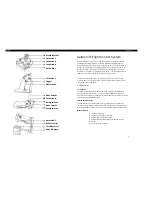
4MELFA-BASIC V
MELFA-BASIC V functions
4-108
(4) Subroutine
Subroutine and subprograms can be used.
By using this function, the program can be shared to reduce the No. of steps, and the program can be cre-
ated in a hierarchical structure to make it easy to understand.
*Command word
*Statement example
*Related functions
Command word
Explanation
GoSub
Calls the subroutine at the designated step or designated label.
On GoSub
Calls the subroutine according to the designated variable number. The value conditions follow
the integer value order. (1,2,3,4,.......)
Return
Returns to the step following the step called with the GoSub command.
CallP
Calls the designated program. The next step in the source program is returned to at the End
statement in the called program. Data can be transferred to the called program as an argument.
FPrm
An argument is transferred with the program called with the CallP command.
Statement example
Explanation
GoSub .......................................................
Calls the subroutine from step.
On GoSub...................................................
Calls the subroutine from label GET.
ON M1 GoSub *L1, *L2, *L3.......................
If the numeric variable M1 value is 1, calls the subroutine at step *L1, if 2 calls the subroutine at step
*L2, and if 3 calls the subroutine at step *L3. If the value does not correspond, proceeds to next step.
Return.........................................................
Returns to the step following the step called with the GoSub command.
CallP "10" ...................................................
Calls the No. 10 program.
CallP "20", M1, P1 ......................................
Transfers the numeric variable M1 and position variable P1 to the No. 20 program, and calls the
program.
FPrm M10, P10 ..........................................
Receives the numeric variable transferred with the CallP in M10 of the subprogram, and the position
variable in P10.
Function
Explanation page
Interrupt........................................................................................
Communication ............................................................................
Page 112, "4.1.5 Communication"
Unconditional branching...............................................................
Page 104, "(1) Unconditional branching, conditional branching, waiting"
















































